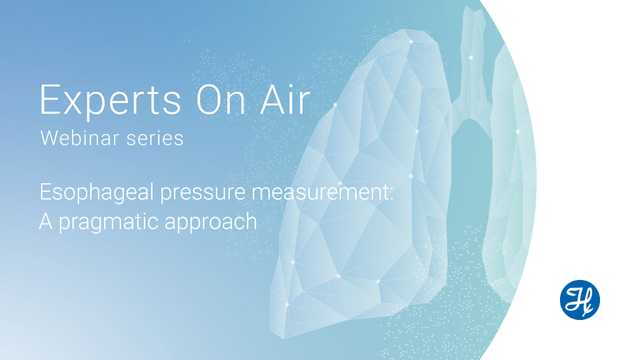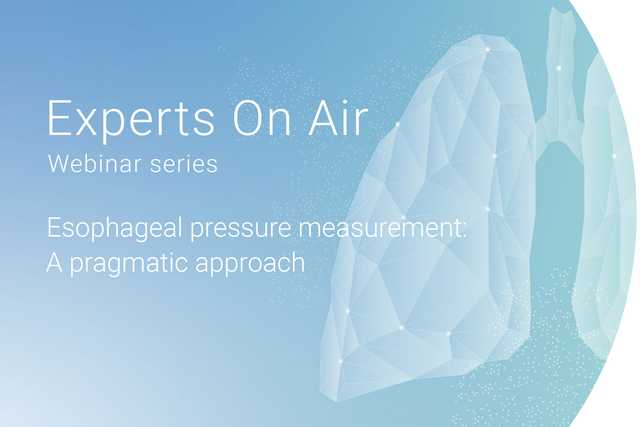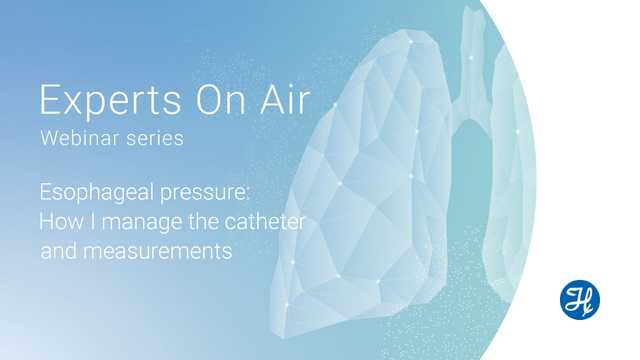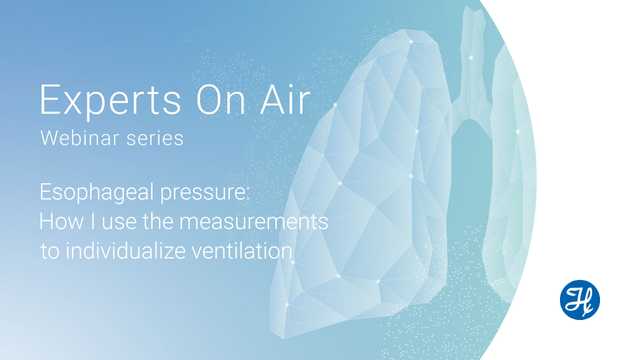

In this second series of Experts On Air, two international experts shared their tips and tricks for using esophageal pressure (Pes) measurement in your daily practice.

Francesco Mojoli and Tommaso Mauri
In this webinar, the experts looked at choosing and positioning the catheter, filling the balloon, and performing the validation test, through to calibrating esophageal pressure. If your question was not addressed during the webinar, you can find some additional answers below.

Francesco Mojoli and Tommaso Mauri
During the second webinar, discussion ranged from the right patient for a Pes-guided approach, through to using Pes to guide the setting of PEEP, tidal volume, and driving pressure. If your question was not addressed during the webinar, you can find some additional answers below.

Cammarota et al. performed the full calibration procedure manually, that is quite time consuming and cumbersome. In fact, after the optimization of the balloon filling, you have to measure the esophageal elastance and compute the esophageal artifact (i.e. the pressure generated by the esophagus). In my opinion, such a procedure can be used in everyday clinical practice only if automated. On the other hand, a calibration should be performed, because otherwise the measured Pes will always be an overestimation of the pleural pressure (due to the pressure generated by the esophagus: measured Pes = pleural pressure + esophagus pressure). The findings of Cammarota et al. are in line with this, showing substantial overestimation of the real pleural pressure and the need for a calibration. In clinical practice, we use the "simplified" calibration procedure, removing from the direct measurement 1 cmH2O for each mL of balloon filling volume above 1 mL. This is a very quick procedure and it provides a calibrated Pes almost superimposed to the reference and acceptable for clinical purposes.
Calibrated Pes is always lower than uncalibrated Pes, because the calibration procedure remove the esophageal artifact, that is the pressure generated by the esophagus.
Editor's note: This topic is to be covered in the second webinar.
In ARDS patients, we perfom a daily assessment. Anyway, every time you change the ventilator setting or the patient's position, it is better to reasses transpulmonary pressure.
It depends on what the indication is for Pes monitoring in the active patient. If I want to monitor his/her inspiratory efforts, I only need to optimize the balloon filling, in order to reliably assess the respiratory changes of pleural pressure. If my aim is to check whether transpulmonary pressure is positive at end-expiration and below my safety threshold at end-inspiration, then I perform the (simplified) calibration.
How to manage difficult insertion of the esophageal balloon catheter:
1) Selection of the catheter (a nasogastric tube equipped with an esophageal balloon is usually inserted very easily, as any standard nasogastric tube)
2) Remove the already inserted nasogastric tube before the insertion of the esophageal catheter, using the same nostril
3) If provided, use the guidewire (if it is difficult to pass into the nasopharynx, you can withdraw the guide by 5-6 cm; NEVER insert the guide again when the catheter is in the patient)
4) Adopt your strategy for the difficult-to-insert nasogastric tube (laryngoscope, Magill, etc.)
No, this rule is catheter specific; 1 cmH2O for each ml above 1 is OK for large balloon catheters (NutriVent), for smaller balloons (Cooper) the rule could be 3 cmH2O for each ml above 0.5 ml. See
This is a very provocative question…but I agree with your point. An oversimplified approach (i.e. suggesting that you can just insert the catheter, read a number and use this number to set the ventilator) has two main drawbacks: 1) Ventilator settings based on wrong Pes measurement do not improve the patient and may eventually worsen the picture. 2) Physicians will start thinking that Pes-guided ventilation does not work and they will abandon it. The approach should be as pragmatic as possible, but an oversimplification is dangerous in my opinion.
I have no personal experience with Pes-guided ventilation in pregnant patients; however, esophageal manometry was used in several studies to assess lower sphincter pressure in early and late pregnancy.
Yes, good indication for Pes monitoring is a heavy or stiff chest wall (morbidly obese patients, IAH patients). In this case the aims are 1) to check whether the high pressure in the airways, eventually exceeding the conventional 30 cmH20 threshold, is still safe for the lung (i.e. the inspiratory transpulmonary pressure is safe) and 2) to keep a positive expiratory transpulmonary pressure, to avoid lung derecruitment and cyclic opening-closing of distal airways. Remember that the latter aim is ONLY for recruitable patients. A simple rule is to consider Pes whenever the ventilation is difficult, i.e. the airway pressure is high, close to or exceeding the conventional safe threshold. I like the opposite indication as well: the small patient with a very thin (and soft) chest wall. In this case my aim is to check whether, even if I'm setting a "safe" pressure in the airways (let's say 28-30 cmH20), mechanical ventilation is really safe. In the active patient under invasive ventilation, Pes can also be used to monitor spontaneous activity (but for intermittent assessment is OK to look at the airway pressure swing during an end-expiratory occlusion). Pes measurement and probably EIT are two techniques very useful in the patient undergoing HFNC, CPAP or NIV, where standard assessment of respiratory mechanics is not possible.
Almost all the techniques to assess lung recruitability are based on a substantial drop of PEEP (usually from 15 down to 5 cmH2O). Thus, frequent assessment of recruitability may promote periodic lung derecruitment, worsening of gas exchange and need of recruitment maneuvers. On the other hand, high potential for lung recruitment is more common in early ARDS than in late ARDS. Therefore, a good compromise is to check recruitability right after intubation. If the patient is recruitable, check again after 3-5 days if he/she is still recruitable; if the patient is not recruitable, do not check again for lung recruitability unless a change in lung morphology and/or unexpected worsening is observed.
R/I ratio is one validated technique to assess lung recruitability at the bedside. It has the general shortcoming of all these techniques: it can suggest high PEEP vs. moderate-low PEEP, but to (precisely) set the optimum PEEP we need additional information such as expiratory transpulmonary pressure. Specific shortcomings of R/I ratio are the measurement of the change of end-expiratory lung volume that is not always easy/feasible with the "single breath" maneuver and the effect of opening-closing on the measurement.
This question is requires a much longer answer that is possible here and may be addressed in future Experts On Air webinars.
This question is requires a much longer answer that is possible here and may be addressed in future Experts On Air webinars.
The contents of this page are for informational purposes only and are not intended to be a substitute for professional training or for standard treatment guidelines in your facility. The responses to the questions on this page were prepared by the respective webinar's speaker; any recommendations made here with respect to clinical practice or the use of specific products, technology, or therapies represent the personal opinion of the speaker only, and may not be considered as official recommendations made by Hamilton Medical AG. Hamilton Medical AG provides no warranty with respect to the information contained ion this page and reliance on any part of this information is solely at your own risk.